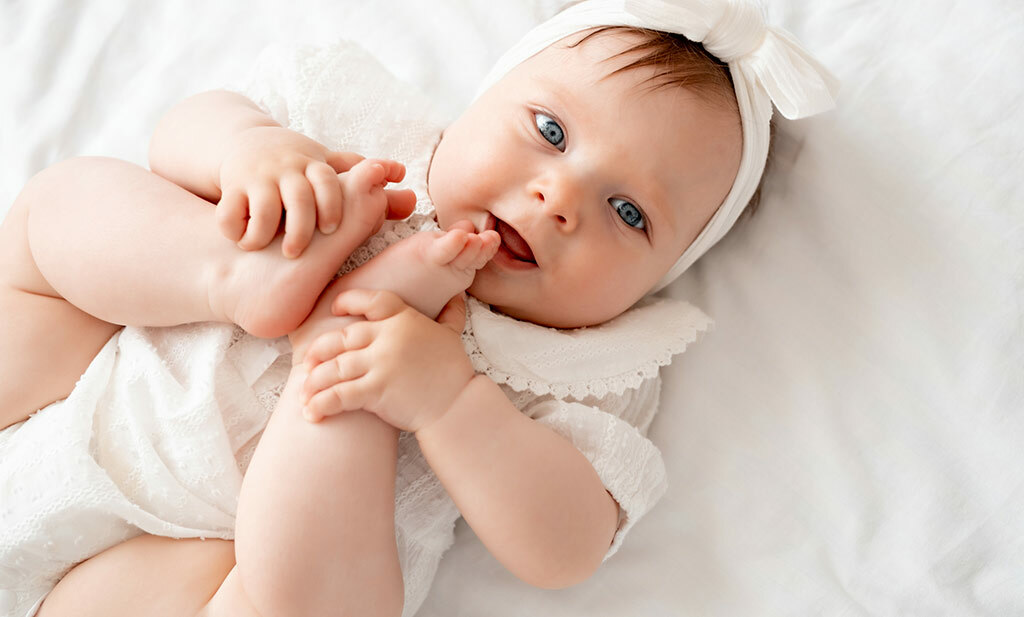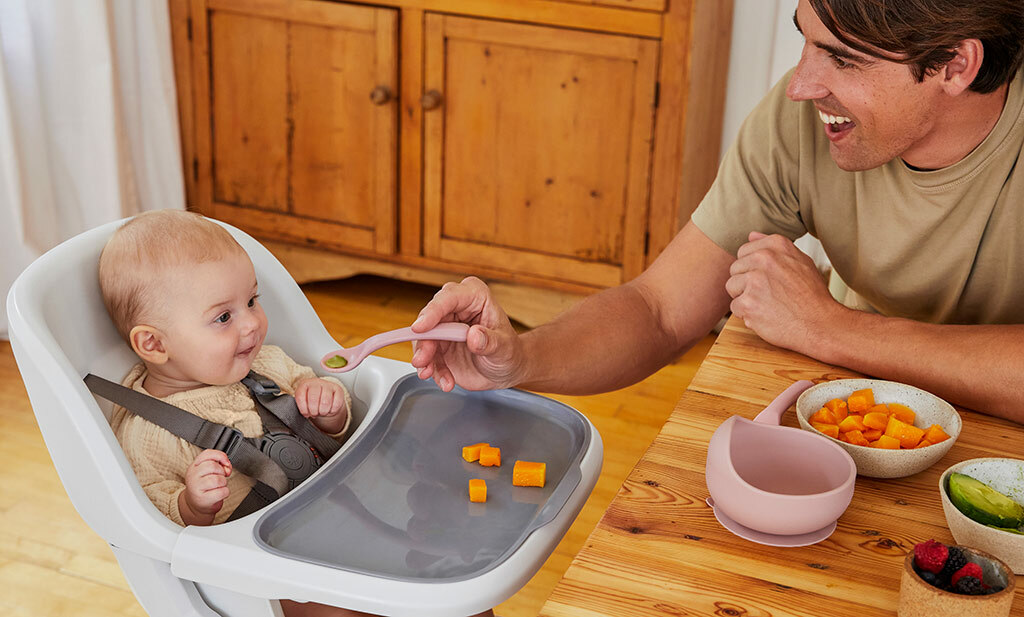
Congratulations! Your little darling is half a year old! It’s amazing how time flies… In today’s instalment of our blog series ‘Baby’s developmental milestones with Ergobaby: baby’s first year’, we want to take a look at what your little one has probably achieved by the end of their sixth month of life together with our midwife and baby expert Katrin Ritter. We say ‘probably’ because each of our babies naturally develops at their own pace. You shouldn’t worry if it takes a little longer for your little one to reach their 6-month-old baby milestones. However, if you notice that your baby’s development is lagging far behind at 6 months, please speak to your health visitor or GP.
6-month-old baby milestones – The development
The big milestone at the end of the sixth month of life is the mature symmetrical hand support. From now on, your baby will be able to balance themself stably on the floor. In addition, their brain is gaining mass as the cerebral hemispheres become more and more interconnected. This means they can coordinate the sides of their body better and better. They also now clearly recognise their parents, understand their first words, smile consciously and consciously show emotions. Their emotional intelligence continues to develop.They will slowly but surely start to understand cause and effect. They are developing ‘their own mind’ and will express it if they aren’t happy. Never out of malice, but because they need guidance from you on how the world works. They want parents who know how to handle things, who they can rely on and who they can trust unconditionally.
Phew, now it’s getting serious, isn’t it? But you’ve got this! And we’re still at the very beginning. Let’s take a closer look at what ‘Baby 6 months development’ has to offer in detail – especially on a physical level. Here we go.
Development baby 6 months – you can observe this progress now:
Playing with your feet on your back
Abdominal muscles, baby! Oh yes, your little darling is working them hard. And because they are getting stronger and stronger, they can now lift their legs so far that their feet (almost) touch their face. Even the lower part of their pelvis leaves the surface. Otherwise, they might grab the lower legs and feet with their hands and work intensively with them.
Turning from back to tummy is successful
Yes! Turning from back to tummy is becoming more and more coordinated and conscious. Whereas last month this was mostly done by accident and by falling, your baby now knows that by reaching over the centre, with the torso bent and legs bent, they can turn onto their side and finally onto their tummy. How practical. For example, they can now reach a toy that is out of reach, or at least move to examine it better.

Incidentally, your baby will usually be able to turn back onto their tummy two weeks later. Keep an eye out… You should also keep an eye on the quality of the turn. Correct turning with strong abdominal muscles is the prerequisite for a long crawling phase and a good upright position. The turn is not correct if your little one does not build up enough abdominal tension and therefore does not bend the trunk, but simply overstretches completely. The twist may be successful this way, but only ‘cheating’.
Symmetrical mature hand support in prone position
Your baby is curious. Until now, tummy time has been done with the help of the immature symmetrical hand support, which means that the fingers – apart from the thumb – were still folded. From the end of the sixth month, however, the hand is completely unfolded, i.e. fully open in mature symmetrical hand support. In order to fight gravity, your baby needs sufficient balance reactions and active abdominal and back muscles. Not bad, right?
Head can be held for longer periods of time
Your baby will also train their neck muscles diligently in the hand support. Their curiosity will help and gradually extend the amount of time they can hold their head up.
Body unfolds from the spine to the hand
We have already described this in the section on mature hand support: Baby’s hands are now fully open. The thumb can be fully spread out and the fingers stretched. Bye, bye innate grasping reflex. But that’s really it now. Both hands are now used to grasp objects more and more purposefully and consciously. The toy is passed from one hand to the other, turned and rotated. Each hand movement becomes more and more differentiated. When grasping, the thumb is now moved inwards towards the little finger. This is the beginning of the tweezer and pincer grip. And you know what? With every grasp, the hemispheres of the brain become more and more interconnected. Mental development progresses.

Development of the short-term memory
Short-term memory develops after the first six months of life. You can test this by hiding a toy under a cloth. Your baby is guaranteed to look for it. Or they will start looking for a toy that they just held in their hand but then dropped. They will remember it and look for it.
The first teeth are coming
By the end of the sixth month, the first two teeth in your baby’s lower jaw are often (not always) already visible. Perhaps your little one is already making their first chewing movements with their lower jaw or has a massive flow of saliva and is very interested in your food? Your child’s individual development and readiness for complementary foods will determine the specific timing. However, in order to eat solid food itself, baby must be able to sit and stay upright, grasp and hold the food, put it in their mouth, chew and swallow it. If your baby shows the typical signs of maturity over the next few weeks and months, this is a sign that you can try out the first solid food. This promotes oral motor skills and therefore learning to speak. Please ask your health visitor or GP for advice on this if you’re unsure.
Bye bye newborn reflexes, hello protective reflexes
Yep, the time has come: your child is sitting up and starting to move around by turning in a coordinated manner. The milestone ‘symmetrical mature hand support’ officially heralds the start of sitting up. The next important step towards an upright gait. By the way: at this point, your baby has completely discarded its newborn reflexes, such as the Moro reflex. Instead, they now have reflexes that serve to protect them throughout their entire life:
- The blink reflex, which protects the eye from foreign objects.
- The acoustic reflex, which causes the baby to blink when it hears a loud bang.
- The jump reflex, which is a support mechanism of the hands and protects us in the event of a fall.
- The external reflexes that enable the body to react quickly before pain reaches the brain. An example of this is pulling your hand away from a hot hob.
6-month-old baby milestones – challenging and encouraging your baby with fun and games
Your baby is halfway to becoming a toddler! Support your little one’s development whenever you can. Use their favourite toys to motivate them to make certain movements that support the 6-month-old baby milestones. Sit on the floor and place them over your thighs so that they can support themselves on the floor or feel the floor with their hands open. Even a careful first ‘wheelbarrow’ (baby supports themself on the floor with their hands and outstretched arms and you carefully lift the legs/pelvis) could be possible if your baby can already support themself well on the floor. Do anything that you and your baby enjoy and that gently and carefully supports your baby’s development.



